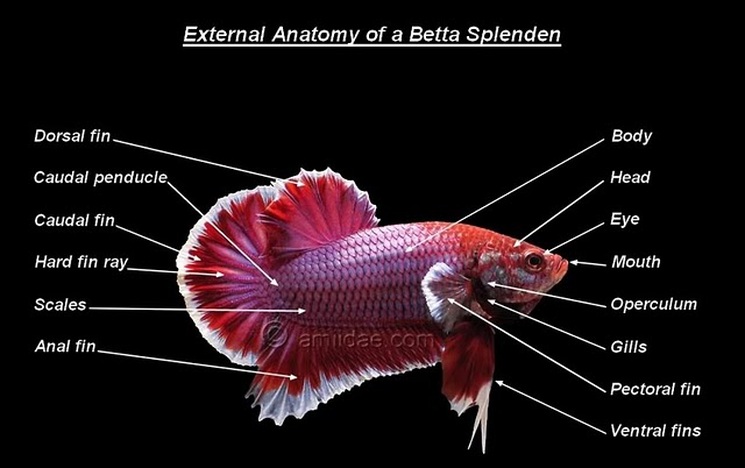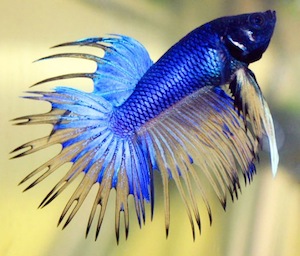Although betta can live in a cup of water, it is a torture for them.
Think about trapped in a 1.5metre box that you can't move freely. You surely can't take it.
Betta need atleast 1 gallon(3.7 litre) of water to allow them swim freely. Bigger, better.
someone even house their betta alone in a 10 gallon tank.
If you felt that it is too empty for a big tank, you can add some tankmates.
Not all tank mate is suitable for betta.
Suitable tankmates for betta are:
small aquarium snails, ghost or red cherry shrimps, cories(corydoras catfish),
white cloud mountain minnows
Slightly compatible:
Neon/cardinal tetras, plecos(small species), Wild guppies(least colorful), rasboras
Least compatible(need more water(5 gallon++) and hiding space):
Fancy guppies, platies, mollies, swordtails
Not compatible:
cichlids, tiger barbs, goldfish , gourami, chinese algae eater
Water temperature:
around 25-30°C( 77-86°F)
If you live in SouthEast Asia, heater is not needed
If heater is used, make sure that the tank is
Decorations:
You can add some decorations into your betta tank.
things they may like are:
something to rest on
something to let them hide
something to swim through
smooth edge decor
Objects prepared with stone, hard plastics, glass or silk (ie - silk plants).Some of them may be poisonous
Water change:
Use tank water or dechlorinated water.
Do full water change once a week if it is a 1 gallon or 2.
2-3 times full water change if less than 1 gallon.
20% partial water change for more than 2gallon every week.
You can add a filter in a (2 gallon+) tank for less water change(make sure water current is slow)
Advise:
If there is any tankmates in a betta tank, make sure that it has more hiding place and
plenty of space(atleast 2 gallon)
Do not put any decorations that are able to slice your betta's fin(T0T), use soft plant or hiding place that have no sharp ends.
Make sure that the top of tank have a cover that have good air ventilation.Betta jumps!!
Warning:
Do not put two male betta in a tank, there will fight until one run away or even death. Some may not fight(very rare), maybe ill or personality.
Betta&Plakat
info of betta splenden, plakat fighter
Wednesday, June 15, 2011
Tuesday, June 14, 2011
Betta's Food
As an animal, betta also need a balance diet too!
Betta feeds on:
livefood : a)bloodworm, b)blackworm, anyworm. c)mosquito larvae, d)brine shrimp(if you have alot of money)
Frozen live food(once alived): a)frozen bloodworm,
Freezed dried food(once alived): mainly a)freezed dried bloodworm b)freezed dried brineshrimp
Betta fish pellet: I recommend Hikari Betta Bio Gold, Sanyu Betta Gold(Cheaper)
Advises:
a)Feed your betta different food everyday(recommended). eg: today=pellet, tomorrow=bloodworm
b)Let your betta skip a day in a week without meal, let your betta to rest its digestive system and prevent bloated tummy.(recommended)
WARNING!: a) Do NOT feed worms that is too big or contain parasites, pesticides.
b) Wash live food throughly before feeding your betta.
c) Do NOT overfeed. read instruction on the food package or ask fishshop
worker
d) Cleanup uneaten food left in the tank.
 sanyu betta gold(8g)
sanyu betta gold(8g)  hikari betta bio gold(2.5g)
hikari betta bio gold(2.5g)
Betta feeds on:
livefood : a)bloodworm, b)blackworm, anyworm. c)mosquito larvae, d)brine shrimp(if you have alot of money)
Frozen live food(once alived): a)frozen bloodworm,
Freezed dried food(once alived): mainly a)freezed dried bloodworm b)freezed dried brineshrimp
Betta fish pellet: I recommend Hikari Betta Bio Gold, Sanyu Betta Gold(Cheaper)
Advises:
a)Feed your betta different food everyday(recommended). eg: today=pellet, tomorrow=bloodworm
b)Let your betta skip a day in a week without meal, let your betta to rest its digestive system and prevent bloated tummy.(recommended)
WARNING!: a) Do NOT feed worms that is too big or contain parasites, pesticides.
b) Wash live food throughly before feeding your betta.
c) Do NOT overfeed. read instruction on the food package or ask fishshop
worker
d) Cleanup uneaten food left in the tank.
Monday, June 13, 2011
Fantail
A Fantail, is a rounded Delta tail. It looks like a fan with rounded edges (unlike the delta which has sharp edges). It is much wider at the ends than it is at the base, resulting in a tail that spreads out open beautifully. If you divide the tail horizontally with an imaginary line, you will have 2 symmetrical parts. Again, there is roundness of the edges. The tail angle may be wider or narrower, depending on the quality of the line.
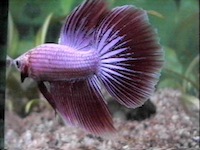 Fantail
Fantail
 Fantail
Fantail
Combtail & Halfsun
The Combtail is a cross of a Crowntail and another tail type. With selected breeding a Combtail can be bred into a Crowntail, but may still carry a dominant gene such as the Veil Tail. They often have the typical droop of the Veil tail but combined with some extended rays on all fins to varying degrees.
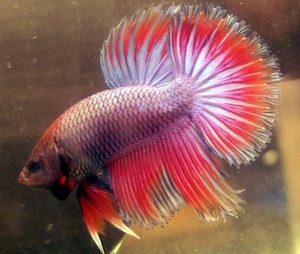 Combtail
Combtail
The Halfsun has come about from selective breeding of the Crowntail and Halfmoon, to create the spread of a Halfmoon with the slight crowning of a Crowntail. This is extremely hard to breed, and specimens may not show full crowning.A combtail betta with a 180 degrees tail span.
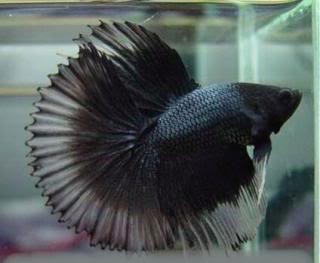 Halfsun
Halfsun
 Combtail
CombtailThe Halfsun has come about from selective breeding of the Crowntail and Halfmoon, to create the spread of a Halfmoon with the slight crowning of a Crowntail. This is extremely hard to breed, and specimens may not show full crowning.A combtail betta with a 180 degrees tail span.
 Halfsun
Halfsun
Crowntail
The Crowntail has become a hugely popular tail type variation. It is unlike any other in the sense that the rays are extended to varying degrees on all fins giving the fish a "spiky" appearance. In show standards, for a fish to be classed as a Crowntail there has to a minimum of 33% reduction in webbing. The reduction on the webbing on Crowntail bettas also varies vastly, sometimes it can be quite full, some times dramatically reduced so only the rays are left. There are three recognised types of crowntail: the double ray, the single ray and the crossed ray. Crossed rays are the most desirable and the most expensive to purchase. There have also been lesser known variations such as the triple ray, even the quadruple ray! Crowntails can have their tails in a full 180 degree spread, or less than a 180 degree spread depending on their breeding. Crowntails are prone to fin curling, especially those with little webbing, if their water is not kept immaculate. Breeders are known to "sun bathe" their Bettas for an hour or so in order to keep their rays straight. It has been found also that when breeding, Crowntails have a heightened amount of aggression compared to other tail types, which can make it challenging to get a successful spawn. Petstores often supply inexpensive Crowntails, who's fins are closer together and not as "crownlike".
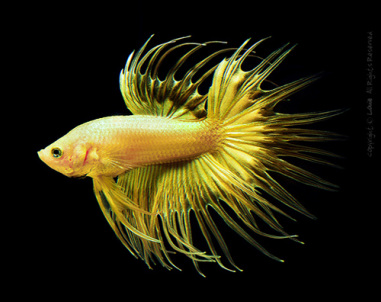
Crowntail

Crowntail
Doubletail
The Double Tail can be seen combined with Plakat, Halfmoon, and even Crowntails. It is a genetic trait that causes the caudal fin to grow into two lobes rather than one. The genes that cause this also cause the body to be shorter and the dorsal and anal fins to be very broad. As the body is effectively stunted in length, Double Tails are more prone to swimbladder problems and this also affects fry survival rates.
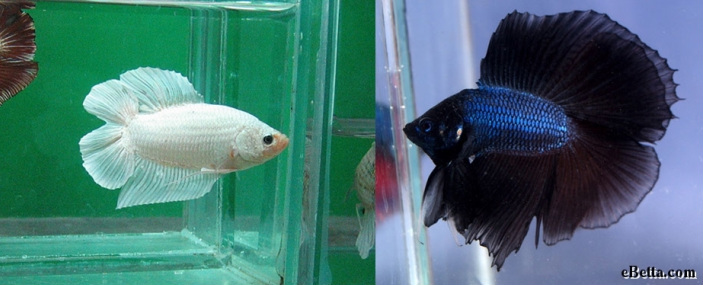
Doubletail Plakat Doubletail Halfmoon

Doubletail Plakat Doubletail Halfmoon
Subscribe to:
Posts (Atom)
